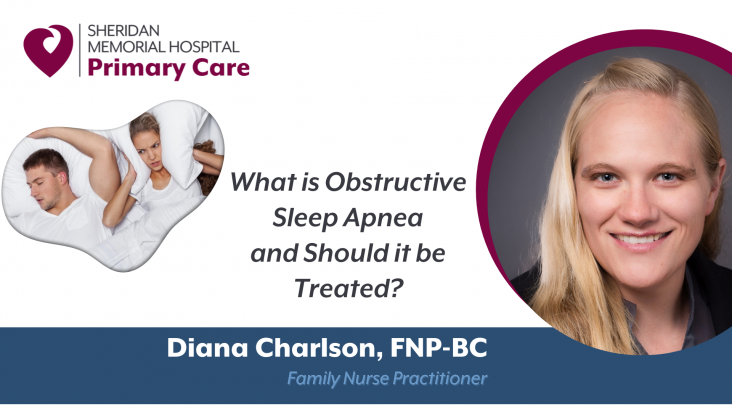By Diana Charlson, FNP-BC, Family Nurse Practitioner at Sheridan Memorial Hospital’s Primary Care
Obstructive sleep apnea (OSA) is the most common type of sleep-disordered breathing. It is caused when the upper airway temporarily closes or collapses. When this happens, the person either doesn’t breathe deep enough (hypopnea) or doesn’t breathe at all (apnea). These are brief episodes that typically happen multiple times throughout the night. During these episodes, the body is not getting appropriate oxygenation, which in turn impacts the entire body, and can cause various problems for people over time.
Because the episodes happen throughout the night, people often don’t know they have a problem. This can cause a delay in the condition getting diagnosed in a timely fashion. Many times, a person won’t get diagnosed for many years. Over time, a person will often begin experiencing symptoms secondary to the ongoing lack of appropriate oxygenation throughout the night. Some indications of OSA include snoring, witnessed apneic events during sleep, waking with headaches in the morning, feeling tired throughout the day, waking up gasping during the night, poor quality of sleep, not feeling rested upon waking, decreased vigilance, high blood pressure, anxiety, and depression.
Some risk factors for OSA include older age (prevalence increases from youth through the sixth to seventh decade), obesity, enlarged neck circumference, having a narrowed airway, family history, and using alcohol or other sedatives.
OSA is diagnosed with a sleep study. This is an overnight test that monitors breathing. In the past, a person needed to go to a formal sleep lab/office to perform a sleep study. However, newer technology allows some people to get a sleep study at home, in the comfort of their own bed! Although the home sleep study is not as comprehensive as the formal sleep lab study, it is still a valid test for many individuals.
The gold standard treatment for sleep apnea is a CPAP (continuous positive airway pressure) machine. Basically, this machine delivers air pressure through a mask, keeping the upper airway open throughout the night and thus preventing hypopnea or apnea. There are other treatment options available, as well.
Long-term, if OSA is not treated, it can lead to many complications. Sometimes a person is diagnosed with OSA after they have been treated for high blood pressure and despite treatment, their blood pressure remains high, which then prompts evaluation into OSA. Other long-term complications include heart arrhythmias such as atrial fibrillation, stroke, and heart failure. It is also linked to insulin resistance, which is a concern for the development of type 2 diabetes. A person with OSA may have more complications with certain medications and major surgeries due to their breathing difficulties and being more prone to breathing problems. Cognition can also be impacted by difficulties with inattention, memory, depression, and anxiety.
Because the presentation of OSA is slow and symptoms may develop over time, it is often not diagnosed for many years. But again, over time, the complications from untreated OSA steadily increase. As we age, we are more prone to complications and often OSA is identified in older individuals. It is important to treat OSA to prevent complications and improve the overall quality of life for both you and anyone who must sleep in the same room as you (as often a person with OSA keeps other people awake at night!)
According to CardioSmart from the American College of Cardiology:
Sleep Apnea by the Numbers
- More than 18 million adults Americans have sleep apnea.
- One in four older people has some degree of sleep apnea.
- 4 out of 5 cases go undiagnosed.
- It occurs in about half of people with heart failure or atrial fibrillation and one-third of people with hypertension and coronary artery disease.
OSA has also been linked to a host of serious cardiovascular problems, including:
- Coronary artery disease (CAD), a narrowing of the blood vessels to supply oxygen to your heart
- Heart attack – people with untreated OSA are twice as likely to have a heart attack
- Stroke
- Sudden cardiac death
- High blood pressure, a major risk factor for heart disease and other medical problems
- Abnormal heart rhythms, especially atrial fibrillation; people with OSA are four times more likely to have a-fib than those without OSA.
If you have questions or concerns about the possibility of having Obstructive Sleep Apnea, please discuss this further with your healthcare provider.

